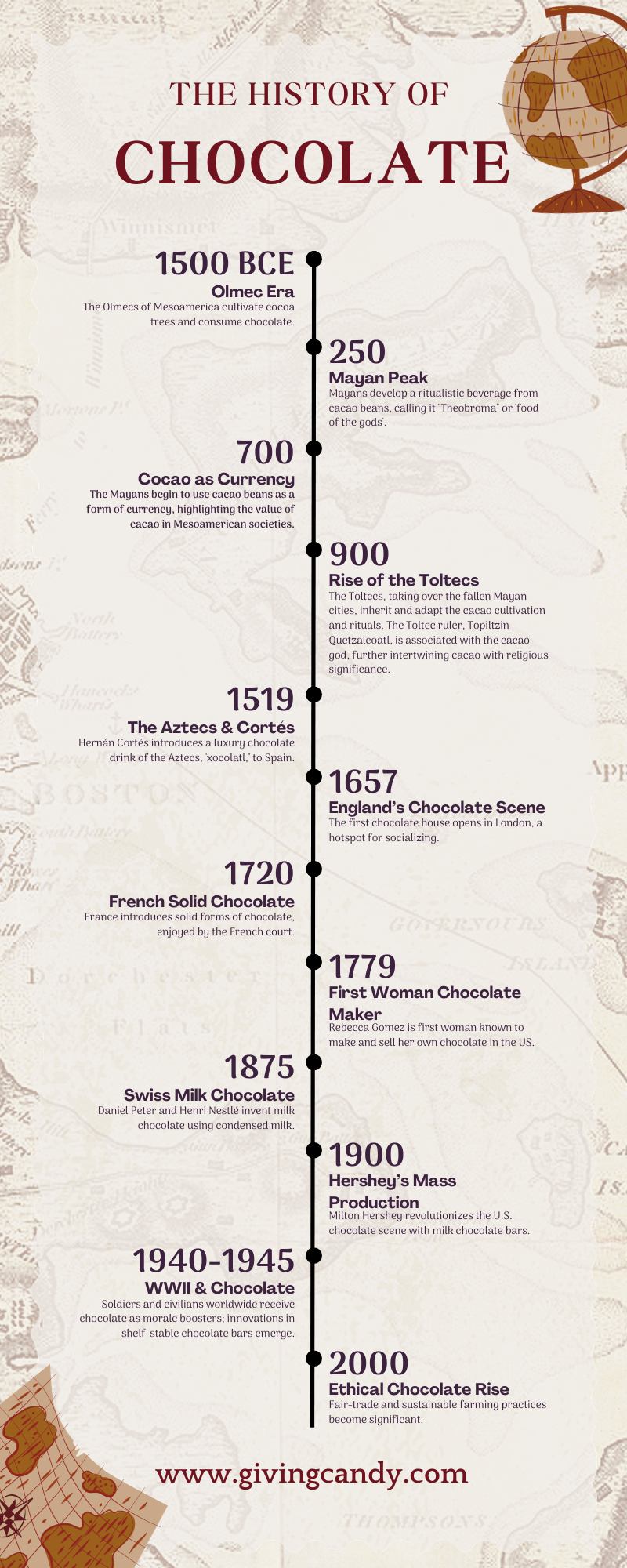
Chocolate, a ubiquitous product in today’s global market, has a multifaceted history spanning thousands of years. To fully appreciate its current role in the world economy and in confectionery innovation, it’s essential to understand its journey. This article delves into key events that have shaped the trajectory of chocolate from ancient Mesoamerica to its contemporary iterations. As research progresses and more insights come to light, we commit to updating this timeline to offer the most comprehensive view.
The Timeline of Chocolate’s Delicious History
- 1500 BCE – Olmec Era: The Olmecs, one of the earliest Mesoamerican civilizations, are believed to have been the first to cultivate cocoa trees. They enjoyed the goodness of chocolate even before it became the global delight that it is today.
- 250 CE – Mayan Peak: The Mayans crafted a ritualistic beverage from cacao beans, which they fondly named “Theobroma” or ‘food of the gods’. This spiritual drink held a special place in Mayan culture.
- 700 CE – Cacao as Currency: Demonstrating the importance of chocolate in their society, the Mayans began using cacao beans as a tangible form of currency.
- 900 CE – Rise of the Toltecs: After the decline of Mayan cities, the Toltecs rose to prominence, inheriting the cacao cultivation and rituals. Their ruler, Topiltzin Quetzalcoatl, became synonymous with the cacao god, strengthening the bond between cacao and religious beliefs.
- 1519 – Aztecs & Cortés: The age of exploration brought Hernán Cortés to the Aztecs. He discovered ‘xocolatl’, a prized Aztec chocolate drink. By 1528, this luxurious beverage made its way to Spain, enhanced with sugar and spices.
- 1657 – England’s Chocolate Scene: The English embraced chocolate, opening the very first chocolate house in London. This became a trendy spot for social events and gatherings.
- 1720 – French Solid Chocolate: France took chocolate innovation a step further by introducing solid forms of chocolate, which became a favorite among the French court.
- 1779 – First Woman Chocolate Maker: Breaking the gender mold, Rebecca Gomez emerged as the first known woman to make and sell her own chocolate in the U.S.
- 1875 – Swiss Milk Chocolate: A collaborative effort between Daniel Peter and Henri Nestlé resulted in the invention of mouth-watering milk chocolate, thanks to the use of condensed milk.
- 1900 – Hershey’s Mass Production: Chocolate underwent a massive transformation in the U.S. with Milton Hershey’s mass production of milk chocolate bars.
- 1940-1945 – WWII & Chocolate: A symbol of comfort and morale, chocolate was distributed to soldiers and civilians during World War II. This era also saw advancements in shelf-stable chocolate bars.
- 2000 – Ethical Chocolate Rise: As the new millennium began, there was a growing emphasis on ethical chocolate production. Fair-trade and sustainable farming practices started gaining momentum.
The trajectory of chocolate from ancient rituals to its current prominence in global markets is a reflection of both cultural adaptations and industry innovations. As professionals in the chocolate industry, having a grasp of this historical context can provide valuable insights into current trends and future possibilities. As the story of chocolate continues to unfold, we will ensure our timeline remains a dynamic and invaluable resource, capturing new details and insights. Let’s continue to study, innovate, and appreciate the complexities and potential of this remarkable commodity.



Recent Comments